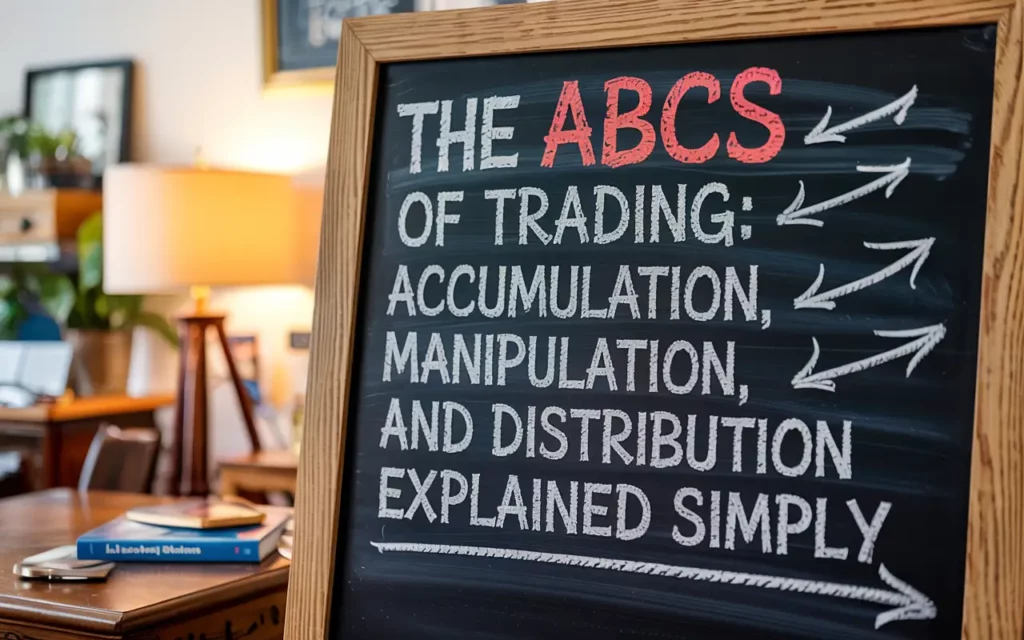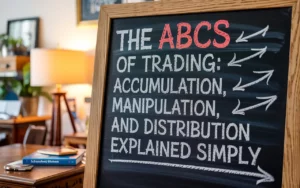If you’re new to trading, the stock or forex markets can seem like a roller coaster. Prices go up and down, and it can be hard to know why. But if you learn how to spot three important stages in the market Accumulation, Manipulation, and Distribution you can make smarter choices.
This guide from The Prop Vault will break it all down in a simple way, so even if you’re just starting out, you’ll understand how markets really move.
1. What Is Accumulation?
Accumulation is the first stage in the market. It happens when prices are low, and smart traders (often called “big players” or “institutions”) quietly start buying.
How It Works:
- Prices have just dropped or moved sideways.
- Most people are scared or tired of losing money.
- The market feels slow or boring.
- Big investors start buying but they do it quietly so the price doesn’t go up too fast.
They’re getting ready for the next big move. This is like planting seeds before the harvest.
Signs of Accumulation:
- Price moves in a sideways range (not going up or down much).
- Volume (how many trades happen) is low.
- News is mostly negative everyone thinks the market is “dead.”
If you’re watching closely, you might see that the market isn’t falling anymore. That’s your clue that big players might be buying.
2. What Is Manipulation?
Now comes the tricky part – Manipulation.
This is when the market makes a sharp move to confuse people. It can go up or down quickly, and the goal is to trick traders into making the wrong decision.
How It Works:
- After accumulation, the price suddenly drops or spikes.
- It’s meant to scare people out of their positions (called a “shakeout”) or trap people into bad trades.
- It often looks like a real breakout but it’s fake.
Big players want to trick small traders. For example, they might drop the price quickly so people sell. Then they buy up more at a discount. Or they push prices up fast so people buy then dump their shares.
Signs of Manipulation:
- Sudden moves with no clear reason.
- False breakouts (the price moves past support/resistance, then quickly reverses).
- High emotions people panic or get too excited.
This stage is short, but it’s very important. If you know it’s manipulation, you won’t fall for the trap.
3. What Is Distribution?
Once the price has gone up and people are excited again, we move to Distribution.
This is when the big players who bought during accumulation now start to sell. They’re cashing in on the big move.
How It Works:
- Prices stop rising and move sideways again.
- Everyone thinks the market is still strong.
- Big players slowly sell without crashing the price.
It’s like a store owner putting all the items on sale after stocking up. They’re selling while the demand is high.
Signs of Distribution:
- Price ranges at the top (after a big rally).
- Volume is higher more people are trading.
- News is positive, and everyone’s talking about “buying the dip.”
But smart traders know this is the time to get out not get in.
4. Why These Stages Matter in Trading
If you can learn to recognize these three stages Accumulation, Manipulation, and Distribution you can plan your trades better.
Here’s how:
| Stage | What Big Players Do | What You Should Do |
|---|---|---|
| Accumulation | Buy slowly and quietly | Start looking to buy |
| Manipulation | Trick other traders | Stay calm and wait |
| Distribution | Sell to the crowd | Look to take profits |
Most beginners buy at the top (during distribution) and sell at the bottom (during accumulation). Understanding these stages helps you do the opposite which is how you win.
5. Real-Life Example (Simple Version)
Let’s say you’re watching a stock that dropped from $100 to $60.
- Accumulation: Price stays around $60 for a while. Not much happens. You notice it doesn’t go lower. Smart money is buying.
- Manipulation: Price quickly dips to $55. Everyone panics. But then boom it jumps back to $65.
- Distribution: Now it slowly climbs to $75. People start buying again. But the price stops going higher and starts moving sideways. Smart money sells. Soon after, the price drops.
If you knew the pattern, you could’ve bought around $60 and sold near $75. That’s how traders stay ahead.
6. How to Spot These Stages on a Chart
You don’t need to be a chart expert, but here are some things to look for:
For Accumulation:
- Look for a flat area after a big drop.
- Volume is lower.
- Candles are small.
For Manipulation:
- Look for a fast move in price either up or down.
- It often happens around support or resistance.
- The move is quickly reversed.
For Distribution:
- Look for a sideways area after a big rise.
- Volume picks up.
- Price starts making lower highs.
There are tools like volume indicators, candlestick patterns, and support/resistance lines that help but even basic charts can show these signs.
7. Key Tips for Traders
- Be patient: Don’t chase price. Wait for signs.
- Avoid trading in manipulation: It’s where most people lose.
- Trade the trend: Enter during or just after accumulation. Exit during distribution.
- Watch volume: It often tells the real story.
Final Thoughts
Trading doesn’t have to be confusing. By understanding the ABCs Accumulation, Manipulation, and Distribution you get a clearer picture of how markets move.
Most traders lose because they don’t know what stage the market is in. But now you do.
So next time you look at a chart, ask yourself:
- Are big players buying or selling?
- Is this move real or a trick?
- Am I following the crowd, or thinking ahead?
When you trade with this knowledge, you’re already one step ahead of most people in the market.
FAQs About Accumulation, Manipulation, and Distribution in Trading
What is the Accumulation Phase in Trading?
The accumulation phase is when smart investors and big institutions quietly buy up assets after a price drop. Prices move sideways, and volume is usually low. It’s the stage where the groundwork is laid for a future price rise.
How Can I Tell If Accumulation Is Happening?
Look for a flat, sideways price range after a downtrend. Volume may stay low, and there’s usually no strong trend. Watch for price refusing to go lower even after bad news — that’s a clue accumulation is happening.
What Does Market Manipulation Mean?
Market manipulation is when prices move sharply up or down in a way that tricks other traders. These moves often create panic or false excitement. It’s used by big players to shake out weak hands or trap people into bad trades.
How Do Traders Spot Manipulation?
Sharp moves that happen without real news, fake breakouts, or fast reversals are common signs of manipulation. If a price suddenly breaks support or resistance and then quickly reverses, it might be a trap.
What Is the Distribution Phase?
Distribution is the stage when prices are high and big investors start selling. The price often moves sideways again, but volume increases. Many traders think the market is still strong, but it’s actually topping out.






